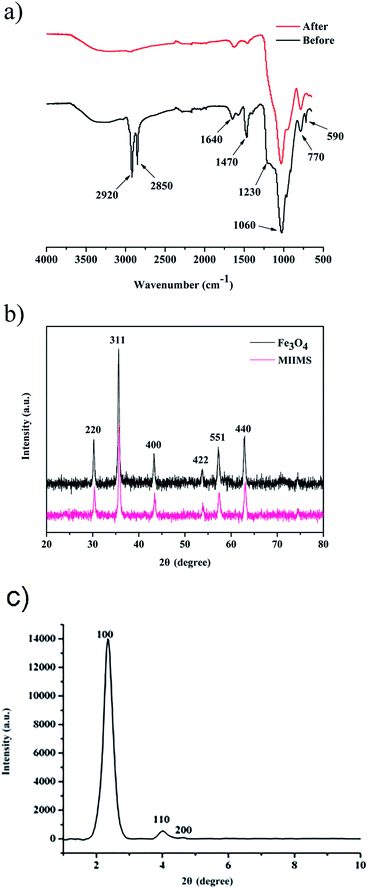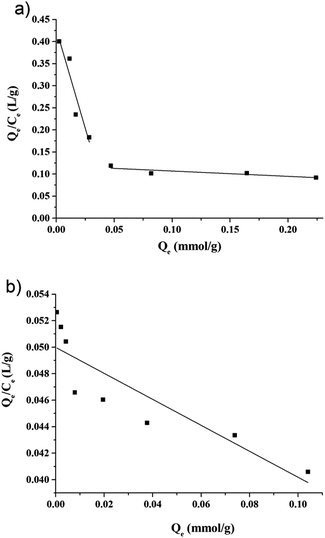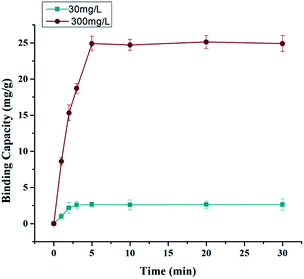 Open Access Article
Open Access ArticleApplication of magnetic Cd2+ ion-imprinted mesoporous organosilica nanocomposites for mineral wastewater treatment
Shuibin Cen a,
Weiming Lic,
Shiying Xud,
Zhihong Wangd,
Youwen Tang*d,
Haishui Wang*a and
Chaohai Weib
a,
Weiming Lic,
Shiying Xud,
Zhihong Wangd,
Youwen Tang*d,
Haishui Wang*a and
Chaohai Weib
aSchool of Chemistry and Chemical Engineering, South China University of Technology, Guangzhou 510641, China. E-mail: wanghsh@scut.edu.cn
bThe Key Lab of Pollution Control and Ecosystem Restoration in Industry Clusters, Ministry of Education, South China University of Technology, Guangzhou, China
cTechnical Service Center Laboratory of Panyu Entry–Exit Inspection & Quarantine Bureau, Guangzhou, China
dMOE Key Laboratory of Laser Life Science, School of Chemistry and Environment, South China Normal University, 510631, Guangzhou, China. E-mail: tanglab@scnu.edu.cn
First published on 23rd January 2017
Abstract
This work demonstrates a simple strategy for producing highly selective adsorption magnetic ion imprinted mesoporous silica (MIIMS) nanocomposites. They have been functionalized by a γ-(aminoethylamino)propyl chelating group for specific recognition and rapid removal of toxic heavy metal ions from wastewaters. The superparamagnetic Fe3O4 nanocrystal was encapsulated in an imprinted mesoporous organosilica shell via a co-condensation synthesis method. The results of transmission electron microscopy (TEM) and small angle X-ray diffraction (XRD) confirmed that the imprinted mesoporous organosilica shell preserved a highly ordered 2D mesostructure. The Brunauer–Emmett–Teller (BET) analysis found the surface area was 946 m2 g−1. The saturated adsorption capacity of MIIMS toward cadmium reached up to 25.2 mg g−1 (0.224 mmol g−1) at pH 5.0. The adsorption of cadmium reached an equilibrium within 4.5 min. The results of a selectivity study revealed that the adsorption capacity for Cd2+ is much high than other co-existing heavy metal ions. The adsorption efficiency of MIIMS was above 94.2% after six extraction-stripping cycles. The MIIMS can efficiently remove cadmium ions in water treatment applications.
1. Introduction
Cadmium is a toxic metal element that causes serious health hazards to humans and has been considered as one of the most serious environmental pollutants. Prolonged exposure to cadmium can very likely cause renal dysfunction, diabetes, cardiovascular diseases and cancers even at a very low concentration.1,2 Many researches have confirmed that cadmium can be transferred from water to plants and to human bodies. Some industrial effluents, such as mining wastewater and waste electroplating solutions, which often have complicated chemical compositions, are the major sources of environmental cadmium pollution.3 Therefore, developing an economic and effective method to remove cadmium from contaminated water is a vital requirement.Plenty of methods for the uptake and elimination of Cd2+ have been put forward, including chemical precipitation, ion exchange, electrochemical treatment, membrane filtration, and adsorption.4–10 Among them, adsorption has attracted growing attentions due to its high efficiency, operation convenience, and environmental friendliness.11 A variety of adsorption materials, viz. activated carbon, polymeric resins, organoclays, humic acids and plants have been developed to remove Cd2+ from contaminated aqueous systems.12 However, several limitations, such as very long adsorption and separation time, low uptake affinity or high cost of manufacturing have inhibited their applications in real environment. Thus, developing of new adsorption materials with high efficiency, wide range of applicability and low cost has become important.
Mesoporous silica has been explored widely as adsorbents of organic compounds, biomolecules and heavy metals due to their large surface area, tunable porosity, uniform pore-size-distribution, controlled morphology and high stability.13–17 However, the anti-interference ability of mesoporous silica in complex samples is relatively poor, which severely hinders its practical applications in water treatment.
Molecularly imprinted polymers (MIPs) have been used as solid phase extraction adsorbents because they possess binding sites with selective recognition capability toward a given target molecule.18 In general, MIPs offer high selectivity, low cost, durability and reusability. Therefore, molecular imprinting has become a well-recognized powerful technique in recent years for developing efficient adsorbents for wastewater treatment.19,20 However, traditional metal ion imprinted polymers (MIIPs) exhibit a low adsorption capacity and poor site accessibility to the target because the binding sites are typically embedded within a highly cross-linked polymer matrix.
Metal ion imprinted mesoporous silica had also been reported in the past.21 Commonly, the mesoporous silica materials can be modified by co-condensation22 and grafting.23 Co-condensation modification involves simultaneous addition of corresponding silica and structure-directing agents (SDAs) with organosilica precursors and template, where the organo-functional groups covalently anchor in the pore walls,24 which can effectively overcome some shortcomings of the grafting synthesis, such as loss of surface area, pore blocking, and heterogeneous distribution of recognition sites.25 Recently, highly ordered metal ion imprinted mesoporous silica have been synthesized by co-condensation for heavy metal wastewater treatment.26 Those nanoparticles with small particle sizes are more advantageous with respect to adsorption equilibrium and kinetics. However, separation of certain substances from multiphase complex systems by ion imprinted mesoporous silica is quite troublesome, introducing certain restrictions in the use of these adsorbents.
In recent years, magnetic mesoporous silica has been extensively investigated due to their combination of multifunctional mesoporous structure and inherent magnetic property. The magnetic nanocomposites could be easily isolated from a matrix by using an external magnetic field instead of centrifuging or filtrating.27–29 By encapsulating magnetic components into ion imprinted mesoporous silica, high molecular accessibility and specific recognition can be combined with magnetic properties to obtain a novel solid phase extraction material with highly selective recognition, large adsorption capacity, fast adsorption kinetics, and simple and rapid solid–liquid separation.30–36
In this work, we reported a novel magnetic ion imprinted mesoporous silica (MIIMS) nanocomposites with a magnetite (Fe3O4) core and highly ordered Cd2+ imprinted mesoporous silica shell via a simply co-condensation synthetic method. The synthesis procedure has been shown in Scheme 1. N-[3-(Trimethoxysilyl)propyl]ethylenediamine (AAPTS) and tetraethoxysilane (TEOS) were chosen as the functional monomer and cross-linker, respectively, while cetyltrimethylammonium bromide (CTAB) was used as the SDAs. The prepared MIIMS was characterized by small angle X-ray diffraction (XRD), transmission electron microscopy (TEM), nitrogen adsorption–desorption isotherms and vibrating sample magnetometer (VSM). Finally, its adsorption behavior in aqueous solutions was investigated and compared to magnetic non-imprinted mesoporous silica (MNIMS).
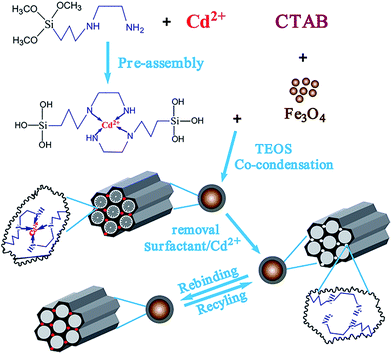 | ||
| Scheme 1 Schematic procedure for synthesis of magnetic Cd2+ imprinted mesoporous silica (CTAB – cetyltrimethylammonium bromide, TEOS – tetraethoxysilane). | ||
2. Materials and methods
2.1. Materials
Nano-iron oxide (Fe3O4, 99%) was purchased from Sima-lab company (Tianjin, China). Tetraethoxysilane (TEOS) and N-[3-(trimethoxysilyl)propyl]ethylenediamine (AAPTS) were obtained from Aladdin Reagent Company (Shanghai, China), while cetyltrimethylammonium bromide (CTAB) was purchased from Sinopharm Chemical Reagent Company (Shanghai, China). CdCl2·2.5H2O, Cu(NO3)2·3H2O, FeCl3·6H2O, Pb(NO3)2 and MgCl2·6H2O were acquired from Tianjin Chemical Reagent Company (Tianjin, China). Acetic acid, ethanol and concentrated ammonia aqueous solution (25 wt%) were purchased from Kermel (Tianjin, China). All chemicals were of analytical grade or better. Double deionized water (DDW) was used as the solvent and for conducting all rinses.2.2. Preparation of MIIMS
In a one-step process, 55 mg CdCl2·2.5H2O and 220 mg AAPTS were dissolved in 10 mL DDW and stirred for 2 h at 60 °C to form a pre-assembly solution. Next, 0.53 g of CTAB and 2.8 g of ammonia aqueous solution (25 wt%) were dissolved in 110 mL of DDW and stirred at 30 °C. Then, 100 mg of Fe3O4 was added to this ammonia solution under vigorous stirring to form a homogeneous dispersion system. After stirring for 0.5 h, the pre-assembly solution was added to this mixture and stirred for another 0.5 h. Following that, 1.08 g TEOS was introduced dropwise into the mixture under vigorous stirring. The stirring was continued for 24 h. The MIIMS product was separated from the mixture by a magnet, and rinsed with ethanol and DDW. Any Cd2+ in the product was extracted by ethanol/HCl (9![[thin space (1/6-em)]](https://www.rsc.org/images/entities/char_2009.gif) :
:![[thin space (1/6-em)]](https://www.rsc.org/images/entities/char_2009.gif) 1, v/v) solution to obtain the final MIIMS product. Magnetic non-imprinted mesoporous silica (MNIMS) was prepared using the same procedure but excluding CdCl2.
1, v/v) solution to obtain the final MIIMS product. Magnetic non-imprinted mesoporous silica (MNIMS) was prepared using the same procedure but excluding CdCl2.
2.3. Apparatus and analytical conditions
Small angle X-ray diffraction (XRD) measurements were conducted with Bruker D8 Advance Scattering system using Cu Kα (λ = 1.5405 Å) radiation over a range of 0.5–10° 2θ. Fourier transform infrared spectra (FTIR) were recorded using a Varian DRX-400 Fourier Transform Spectrophotometer. The target compounds were also characterized by transmission electron microscope (TEM, Hitachi HT7700, Japan). N2 adsorption–desorption measurements were carried out at 77 K using Belsorp-Max surface area and pore size analyzer. Surface areas were calculated by the Brunauer–Emmett–Teller (BET) method, and the pore volume and pore-size distributions were calculated using the Barret–Joyner–Halenda (BJH) model. Metal ion concentrations were recorded on a Varian 730 ES Inductive Coupled Plasma Emission Spectrometer.2.4. Adsorption experiment
Adsorption experiments were carried out using 10 mg MIIMS or MNIMS and 10 mL solution at 25 °C. The pH of the solution was adjusted by using an acetic acid/sodium acetate buffer solution. For the pH test, MIIMS or MNIMS were added at different pH (2.0–6.0) of Cd2+ solution (300 mg L−1) in each vial. The calculated imprinting factor (IF) was defined as IF = Bi/Bn, where Bi and Bn represented the binding capacity of MIIMS and MNIMS, respectively. After each adsorption cycle, the MIIMS or MNIMS were separated by a magnet, and the residual concentration of Cd2+ in the supernatant was measured. All the adsorption experiments were conducted in triplicate, and the mean values are reported.A series of Cd2+ solutions in the range of 5 to 500 mg L−1 at pH 5.0 was used to investigate the isothermal adsorption experiments. The adsorption kinetics tests were performed using Cd2+ solutions of two different concentrations (30 and 300 mg L−1). After shaking for regular time, the MIIMS was separated, and the residual concentration of Cd2+ in the solution was measured by ICP-MS.
In order to measure selectivity of the MIIMS, solutions of Cd2+, Cu2+, Pb2+, Mg2+ and Fe3+ (1 mmol L−1) were used, and the pH of each solution was maintained at 5.
2.5. Reusability and reproducibility
Cd2+ solution of concentration 300 mg L−1 at pH 5.0 was used for testing the reusability and reproducibility of the MIIMS. In each cycle, the Cd2+ absorbed by the MIIMS was eluted with 4 mL of 2 mol L−1 HCl. The MIIMS was washed thrice with DDW, neutralized with 1 M NaOH, again rinsed thrice with DDW, and dried. The dried MIIMS was then used for the next adsorption cycle. The same MIIMS was reused 6 times for adsorption of Cd2+ to measure its reusability. Additionally, five batches of MIIMS prepared at different times were employed to evaluate the reproducibility of MIIMS.2.6. Removal of Cd2+ from water samples
Sample of mineral wastewater was collected in a polyethylene bottle from Shangba Dam (Guangdong, China) with pH 2.8 and Cd2+ concentration of 0.27 mg L−1. The water sample was filtered through a 0.45 μm micro filtration membrane to remove all impurities, and the pH was adjusted to 5. Then, 100 mg of MIIMS was used to adsorb Cd2+ from 10 mL of the mineral wastewater. After shaking for 10 min, the MIIMS was separated and the residual concentration of Cd2+ in the solution was analyzed by ICP-MS. The recycle approach of the MIIMS was same as that of the reusability experiment mentioned above.3. Results and discussion
3.1. Characterization of MIIMS
Low-angle XRD pattern of MIIMS is shown in Fig. 1c, three characteristic diffraction peaks of (100), (110) and (200) were observed, which revealed that the MIIMS owned a long range ordering of the porous structure and well-formed hexagonal pore arrays despite the embedding of iron oxide nanoparticles.
3.2. Binding properties of MIIMS
The complexation between heavy metal ions and ligand diamine groups are strongly influenced by the ambient pH. Thus experiments were performed to explore the effects of solution pH on the adsorption capacity and imprinting factor (IF) of the MIIMS. Fig. 3 showed that the binding capacity of MIIMS toward Cd2+ was positively correlated with the pH (range from 2.0–6.0), while the IF showed a negative one. The largest adsorption capacity (approximately 29.1 mg g−1) and IF (2.5) was observed at solution pH of 6.0 and 2.0, respectively. This could be attributed to the degree of protonation of the electron-donating nitrogen atoms in the Cd2+ imprinted cavities, which reduced the binding ability of the amino group involved in chelation with Cd2+. However, MNIMS adsorbed Cd2+ through nonspecific binding, which was weak compared to the specific adsorption exhibited by the MIIMS (Fig. 4).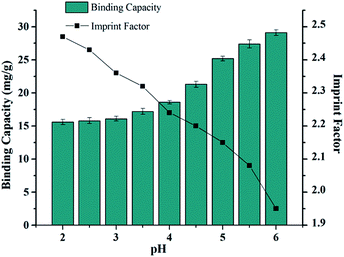 | ||
| Fig. 3 The effect of pH on adsorption capacity and IF of MIIMS (experimental conditions: used 10 mL of 300 mg L−1 Cd2+ solution, solid weight 10 mg, T = 298 K). | ||
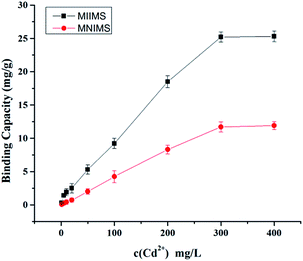 | ||
| Fig. 4 Adsorption capacity of MIIMS and MNIMS (experimental conditions: used 10 mL of different concentrations of Cd2+ solution at pH 5.0, solid weight 10 mg, T = 298 K). | ||
When the pH value was low, the binding capacity of MIIMS was small, while precipitation of the metal hydroxide was expected at a high pH. Accordingly, we measured the adsorption tests within a pH range of 2.0 to 6.0, for the purpose of estimating the optimum pH. Synthesizes the binding capacity and selectivity, we used an acetic acid/sodium acetate buffer solution with a pH of 5 for conducting subsequent adsorption tests.
Scatchard analysis (Fig. 5) was used to estimated the binding data for assess the adsorption properties of MIIMS. The Scatchard equation is as follows:
 | (1) |
3.3. Kinetic study
Two different concentrations of Cd2+ solutions were used for the adsorption kinetic study of the MIIMS. The results (Fig. 6) showed the equilibrium adsorption time is longer at high concentration of Cd2+. For concentrations of 30 and 300 mg L−1, the adsorption of Cd2+ reached equilibrium within 3.0 and 5.0 min, respectively. The times to reach adsorption equilibrium were much faster than that of a typical molecularly imprinted polymer adsorbent,39,40 and it was basically in line with common imprinted mesoporous silica.26 We believe that the nanometer-sized wall thicknesses and large pore size of the mesoporous silica allowed Cd2+ to readily access the imprinted sites.To study the adsorption kinetics of Cd2+ onto MIIMS, pseudo-first-order and pseudo-second-order kinetic models were used. The pseudo-first-order kinetic model is as follows.
log(Qe − Qt) = log![[thin space (1/6-em)]](https://www.rsc.org/images/entities/char_2009.gif) Qe − k1t Qe − k1t
| (2) |
The pseudo-second-order kinetic model is as follows.
 | (3) |
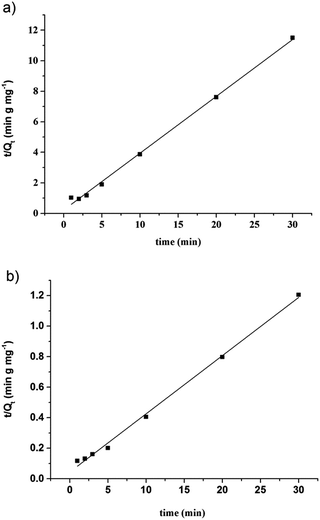 | ||
| Fig. 7 The pseudo-second-order model of adsorption kinetics of MIIMS in solution (30 mg L−1 (a); 300 mg L−1 (b)). | ||
3.4. Selectivity study
In order to further confirm that the obtained MIIMS nanoparticles can selectively recognize Cd2+, even in a mixed solution containing other metal ions, we performed competitive adsorption study with Cu2+, Pb2+, Mg2+ and Fe3+. These ions were chosen as they could coexist in wastewaters with Cd2+, and they have same charge and similar ionic radius with Cd2+. In addition, Fe3+ is a common ion in aquatic environments and is often detected at high concentrations in some water samples. As showed in Fig. 8, the adsorption capacities of MNIMS toward all the ions were not significantly different, while that of MIIMS to Cd2+ was much higher than its adsorption capacities toward Cu2+, Pb2+, Mg2+ or Fe3+. The results indicated that the MIIMS possessed good selective recognition ability, which stem from the imprinting effect of the MIIMS. Note that MNIMS had almost no selectivity, which was due to the random distribution of the chelating ligands in the mesoporous silica.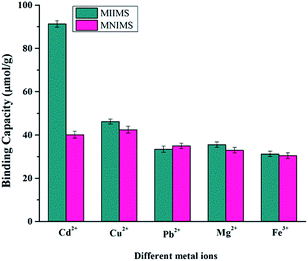 | ||
| Fig. 8 Selective adsorption experiments of MIIMS and MNIMS (experimental conditions: initial concentrations of metal ions 1 mmol L−1, 10 mL solution at pH 5.0, 10 mg adsorbent, T = 298 K). | ||
3.5. Reusability and reproducibility
Reusability is a valuable attribute for economically viable adsorbent, and so we studied the reusability performance of MIIMS. Hydrochloric acid (4 mL, 2 mol L−1) was utilized to elute the Cd2+ adsorbed by MIIMS for reuse. Fig. 9 indicated that MIIMS displayed good reusability without experiencing a marked decline in its adsorption capacity. The adsorption capacity of MIIMS reached 94.2% even after six cycles. However, the decrease of adsorption capacity of MIIMS is inevitable after many adsorption–regeneration cycles, which is a general feature of most imprinting polymers.41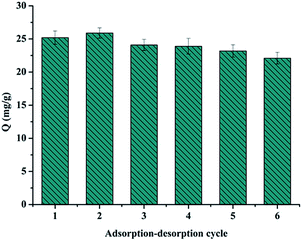 | ||
| Fig. 9 Reusability of MIIMS (experimental conditions: 10 mL of 300 mg L−1 Cd2+ solution at pH 5.0, 10 mg adsorbent, T = 298 K). | ||
The reproducibility also was investigated, and five batches of MIIMS prepared at different times were used. The relative standard deviations for the reproducibility of MIIMS were less than 4.2% between all the samples. The above results demonstrated that freshly synthesized magnetic mesoporous nanoparticles possessed satisfactory reusability and reproducibility performances.
3.6. Application of actual wastewater sample
To demonstrate the applicability of MIIMS to remove Cd2+ in real world sample, we collected the mineral wastewater from the Shangba Dam. The initial Cd2+ concentration in the mining effluent was 0.27 mg L−1 with a pH of 2.8. After the wastewater was adjusted to pH 5, and treated using 100 mg of MIIMS, the residual Cd2+ concentrations decreased to 0.03 mg L−1. By adding 10 g of MIIMS to per liter of the mining effluent, the concentration of Cd2+ was less than the discharge standard (0.1 mg L−1) of China.4. Conclusions
In this paper, we introduced a set of procedures to fabricate magnetic ion imprinted mesoporous silica core shell nanocomposites with highly ordered periodic structure via a co-condensation method. The MIIMS combined the advantages of molecularly imprinted polymers, mesoporous silica materials, and magnetic materials. The MIIMS remains highly selective recognition, high adsorption capacity (25.2 mg g−1) and rapid adsorption kinetics (reach equilibrium within 4.5 min). By encapsulating magnetic core into ion imprinted mesoporous silica, MIIMS is quite easy to be separated and recycled, which makes it a novel solid phase extraction adsorbent. Therefore, it is convenient to apply MIIMS for the wasterwater treatment to remove cadmium presented in mineral effluent effectively and efficiently. Besides, this synthetic approach was simple, effective, economic, safe, environment friendly, and processes a good reproducibility, so it could also be used to prepare other metal ions imprinted mesoporous silica magnetic adsorbents. The wastewater treatment applications show that the concentration of Cd2+ was lower than the discharge standard of China, resulting from the usage of MIIMS. However, the decrease of adsorption capacity of MIIMS is inevitable after many adsorption–regeneration cycles, which needs further researches.Acknowledgements
We gratefully acknowledge the financial support from the NSFC-GD Joint Foundation of the Key Projects (No. U1201234) and National Natural Science Foundation of China (No. 21275057).References
- K. F. Lam, K. L. Yeung and A. G. Mckay, Environ. Sci. Technol., 2007, 41, 3329–3334 CrossRef CAS PubMed.
- P. N. Williams, M. Lei, G. X. Sun, Q. Huang, Y. Lu, C. Deacon, A. A. Meharg and Y. G. Zhu, Environ. Sci. Technol., 2009, 43, 637–642 CrossRef CAS PubMed.
- E. Álvarez-Ayuso and A. García-Sánchez, J. Hazard. Mater., 2007, 147, 594–600 CrossRef PubMed.
- N. Meunier, P. Drogui, C. Montané, R. Hausler, G. Mercier and J. F. Blais, J. Hazard. Mater., 2006, 137, 581–590 CrossRef CAS PubMed.
- M. Y. Vilensky, B. Berkowitz and A. Warshawsky, Environ. Sci. Technol., 2002, 36, 1851–1855 CrossRef CAS PubMed.
- K. L. Huang, T. M. Holsen, T. C. Chou and J. R. Selman, Environ. Sci. Technol., 2003, 37, 1992–1998 CrossRef CAS PubMed.
- C. A. Bashaa, M. Somasundaramb, T. Kannadasanb and C. W. Lee, Chem. Eng. J., 2011, 171, 563–571 CrossRef.
- J. Gao, S. P. Sun, W. P. Zhu and T. S. Chung, Water Res., 2014, 63, 252–261 CrossRef CAS PubMed.
- Y. Zhang, Y. Chen, C. Wang and Y. Wei, J. Hazard. Mater., 2014, 276, 129–137 CrossRef CAS PubMed.
- C. Han, W. Cai, W. Tang, G. Wang and C. Liang, J. Mater. Chem. A, 2011, 21, 11188–11196 RSC.
- Y. K. Seo, J. W. Yoon, J. S. Lee, Y. K. Hwang, C. H. Jun, J. S. Chang, S. Wuttke, P. Bazin, A. Vimont, M. Daturi, S. Bourrelly, P. L. Llewellyn, P. Horcajada, C. Serre and G. Férey, Adv. Mater., 2012, 24, 806–810 CrossRef CAS PubMed.
- M. A. Barakat, Arabian J. Chem., 2011, 4, 361–377 CrossRef CAS.
- L. X. Zhang, H. Y. Niu, W. H. Li, Y. L. Shi and Y. Q. Cai, Chem. Commun., 2011, 47, 4454–4456 RSC.
- L. Zhang, S. Qiao, Y. Jin, H. Yang, S. Budihartono, F. Stahr, Z. Yan, X. Wang, Z. Hao and G. Lu, Adv. Funct. Mater., 2008, 18, 3203–3212 CrossRef CAS.
- Q. Meng, X. Zhang, C. He, G. He, P. Zhou and C. Duan, Adv. Funct. Mater., 2010, 20, 1903–1909 CrossRef CAS.
- C. Kang, W. Li, L. Tan, H. Li, C. Wei and Y. Tang, J. Mater. Chem. A., 2013, 1, 7147–7153 CAS.
- H. Liu and W. Chen, RSC Adv., 2015, 5, 27034–27042 RSC.
- L. Chem, X. Wang, W. Lu, X. Wu and J. Li, Chem. Soc. Rev., 2016, 45, 2137–2211 RSC.
- Y. Cai, L. Zheng and Z. Fang, RSC Adv., 2015, 5, 97435–97445 RSC.
- M. Razali, J. F. Kim, M. Attfield, P. M. Budd, E. Drioli, Y. M. Lee and G. Szekely, Green Chem., 2015, 17, 5196–5205 RSC.
- S. Dai, M. C. Burleigh, Y. Shin, C. C. Morrow, C. E. Barnes and Z. L. Xue, Angew. Chem., Int. Ed., 1999, 38, 1235–1239 CrossRef CAS.
- J. Tan, H. F. Wang and X. P. Yan, Anal. Chem., 2009, 81, 5273–5280 CrossRef CAS PubMed.
- S. Xu and H. Lu, Chem. Commun., 2015, 51, 3200–3202 RSC.
- K. Suzuki, K. Ikari and H. Imai, J. Am. Chem. Soc., 2004, 126, 462–463 CrossRef CAS PubMed.
- W. Zhao, J. Gu, L. Zhang, H. Chen and J. Shi, J. Am. Chem. Soc., 2005, 127, 8916–8917 CrossRef CAS PubMed.
- R. He, W. Li, D. Deng, W. Chen, H. Li, C. Wei and Y. Tang, J. Mater. Chem. A, 2015, 3, 9789–9798 CAS.
- J. Kim, H. S. Kim, N. Lee, T. Kim, H. Kim, T. Yu, I. C. Song, W. K. Moon and T. Hyeon, Angew. Chem., Int. Ed., 2008, 47, 8438–8441 CrossRef CAS PubMed.
- Q. Yuan, N. Li, Y. Chi, W. Geng, W. Yan, Y. Zhao, X. Li and B. Dong, J. Hazard. Mater., 2013, 254, 157–165 CrossRef PubMed.
- S. W. Jun, M. Shokouhimehr, D. J. Lee, Y. J. Jang, J. Park and T. Hyeon, Chem. Commun., 2013, 49, 7821–7823 RSC.
- Y. Deng, D. Qi, C. Deng, X. Zhang and D. Zhao, J. Am. Chem. Soc., 2008, 130, 28–29 CrossRef CAS PubMed.
- G. Cheng, J. Zhang, Y. Liu, D. Sun and J. Ni, Chem. Commun., 2011, 47, 5732–5734 RSC.
- L. Zhang, T. Wang, L. Li, C. Wang, Z. Su and J. Li, Chem. Commun., 2012, 48, 8706–8708 RSC.
- S. Gai, P. Yang, P. Ma, D. Wang, C. Li, X. Li, N. Niu and J. Lin, J. Mater. Chem. A, 2011, 21, 16420–16426 RSC.
- C. Wang, S. Tao, W. Wei, C. Meng, F. Liu and M. Han, J. Mater. Chem., 2010, 20, 4635–4641 RSC.
- X. Xin, Q. Wei, J. Yang, L. Yan, R. Feng, G. Chen, B. Du and H. Li, Chem. Eng. J., 2012, 184, 132–140 CrossRef CAS.
- O. Hakami, Y. Zhang and C. J. Banks, Water Res., 2012, 46, 3913–3922 CrossRef CAS PubMed.
- A. Benhamou, M. Baudu, Z. Derriche and J. P. Basly, J. Hazard. Mater., 2009, 171, 1001–1008 CrossRef CAS PubMed.
- S. Y. Xu, C. J. Guo, Y. X. Li, Z. R. Yu, C. H. Wei and Y. W. Tang, J. Hazard. Mater., 2014, 264, 34–41 CrossRef CAS PubMed.
- S. Piszkiewicz, E. A. Kirkbride, N. D. Stearns, B. R. Henderson, M. A. Lenker, E. Tang, L. H. Kawashiri, C. S. Nichols, S. C. Moore and S. G. Sogo, Chem. Commun., 2013, 49, 5954–5956 RSC.
- T. Chang, Y. Liu, X. Yan, S. Liu and H. Zheng, RSC Adv., 2016, 6, 66297–66306 RSC.
- J. Kupai, M. Razali, S. Buyuktiryaki, R. Kecili and G. Szekely, Polym. Chem., 2017 10.1039/c6py01853j.
| This journal is © The Royal Society of Chemistry 2017 |

